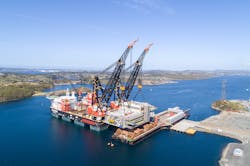Norway heading for record offshore project activity in 2022
Offshore staff
LONDON – Norway’s production will keep growing next year, with potentially a record number of final investment decisions on new offshore projects, according to Wood Mackenzie.
Overall production from the sector should rise above 4 MMboe/d, helped by start-ups such as Equinor’s Johan Sverdrup Phase 2 and Njord Future, and Wintershall DEA’s Dvalin.
And permits to step up gas exports at Troll and Oseberg should take effect, boosting Norwegian gas output to record levels, up from the previous high of 125 bcm in 2017.
Neivan Boroujerdi, Wood Mackenzie’s principal analyst, European upstream, said: “We also expect companies to book record profits next year. Cost cutting carried out during previous downturns will combine with strong prices to generate cash flow generation levels never seen before on the Norwegian continental shelf.”
At the same time, overall investment on the shelf looks set to slip to $17 billion, the lowest since 2003, although spending will rise again once the FIDs take effect.
Up to 25 projects could be sanctioned, incurring more than $30 billion of investment. The main driver is Norway’s temporary easing of its fiscal terms – due to expire in 12 months.
NOAKA and Wisting in the North Sea and Barents Sea will likely account for over one-third of the 2.5 Bboe-plus to be developed.
Boroujerdi added: “Average project break-evens are below $30/bbl, making these projects some of the most competitive globally. But the spike in activity will stretch the Norwegian supply chain, which means longer lead times and higher rig rates are possible.”
Next year five more electrification projects, with total investments of $3 billion, should go forward for existing and new developments.
As for new exploration activity, up to 30 wildcats could be drilled, accounting for nearly 10% of the global well count, the consultants believe, with Equinor and Aker BP/Lundin Energy (preparing to merge) accounting for over 35% of the wells on a net basis.
Drilling will target around 2 Bboe, with the Vøring basin off mid-Norway under particular scrutiny. However, Barents Sea drilling could drop to a 10-year low as explorers in general opt instead for near-field exploration.
ConocoPhillips plans to appraise its recent Slagugle and Warka finds.
If Norway’s new Labor government pursues changes to the fiscal system, this could lead to an uptick in M&A activity, Boroujerdi suggested. “The removal of the exploration tax rebate should prompt some tax-driven deals by the smaller, more organic focused players.
“We could also see the first oil and gas IPO in Europe since 2019: the timing of which would coincide with some private equity investment cycles. Var Energi is the latest to suggest an IPO. Other North Sea-focused E&Ps will be exploring their options.”
Next year the North Sea will become a global focus for capture and storage, and more Norwegian oil and gas operators may consider options for offshore wind power, with Equinor’s Hywind Tampen in the North Sea due to be the first floating offshore wind development to power upstream oil and gas operations.
12/27/2021



